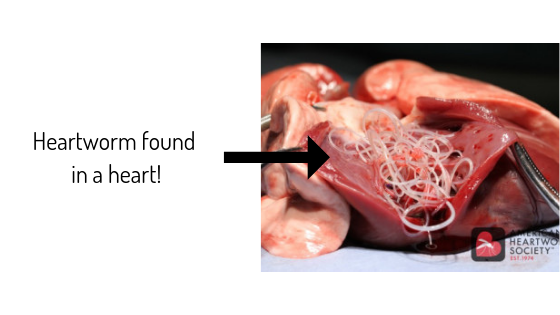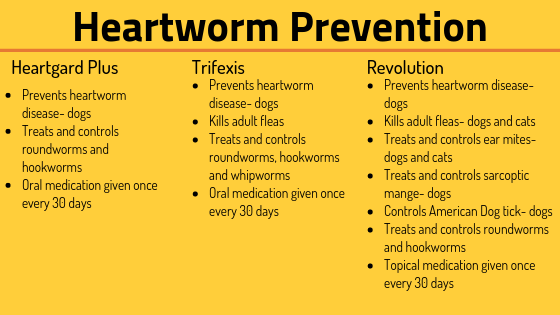Heartworm Disease
Heartworm Disease

What is Heartworm?
Heartworms live in the heart, lungs, and the surrounding blood vessels of pets, causing severe lung disease, heart failure, and damage to other organs in the body. These worms can grow to be feet long! Heartworm disease can affect other species too such as ferrets, wolves, coyotes, and foxes.
How is heartworm transmitted?
The mosquito plays an essential role in the heartworm life cycle. Mosquitos are how heartworm is transmitted from animal to animal. Adult female heartworms living in an infected dog (or other species) produce microscopic baby worms called microfilaria that circulate in the bloodstream. When a mosquito bites and takes a blood meal from an infected animal, it picks up these baby worms, which develop and mature into “infective stage” larvae over a period of 10 to 14 days. Then, when the infected mosquito bites another dog, the infective larvae are injected into the new host through the mosquito’s bite wound. Once inside a new host, it takes approximately 6 months for the larvae to mature into adult heartworms. Once mature, heartworms can live for 5 to 7 years in dogs. Because of the longevity of these worms, each mosquito season can lead to an increasing number of worms in an infected pet. If untreated, their numbers can increase, and dogs have been known to harbor several hundred worms in their bodies. Heartworm disease causes lasting damage to the heart, lungs, and arteries, and can affect the dog’s health and quality of life long after the parasites are gone.


What are the signs of heartworm in dogs?
In the early stages of the disease, many dogs show few symptoms or no symptoms at all. The longer the infection persists, the more likely the symptoms will develop. Active dogs, dogs heavily infected with heartworms, or those with other health problems will often show clinical signs.
Signs of heartworm disease may include a mild persistent cough, reluctance to exercise, fatigue after moderate activity, decreased appetite, and weight loss. As heartworm disease progresses, pets may develop heart failure and the appearance of a swollen belly due to excess fluid in the abdomen (condition of heart disease). Dogs with large numbers of heartworms can develop sudden blockages of blood flow within the heart leading to a life-threatening form of cardiovascular collapse. This is called caval syndrome and is marked by a sudden onset of labored breathing, pale gums, and dark bloody or coffee-colored urine. Without prompt surgical removal of the heartworm blockage, few dogs survive.
What is the risk of heartworm in New York?
Transporting and relocating dogs have become increasingly common practices for many valid reasons. Whether the situation is a pet accompanying their traveling owners or the necessary relocation of homeless animals for adoption, these exercises carry a risk of spreading infectious diseases. This includes the transmission of heartworm disease.
The devastation that followed Hurricanes Harvey and Irma increased the threat of heartworm disease through the relocation of dogs who lived in endemic heartworm areas into new communities, including New York State, where heartworm was not common. While many of these loving and well-deserving pets from these areas needed their forever homes, many of them were afflicted with this serious disease. The same incident occurred following Hurricane Katrina. Following that storm, nearly 250,000 pets were adopted and transported throughout the country forever changing the incidence of heartworm in many areas of the country. The American Heartworm Society and fellow veterinarians in clinics and shelters throughout Texas and Florida warned that nearly 80% of dogs over 6 months of age could be heartworm positive.

To also reduce the risk of heartworm for your pet at home, heartworm prevention is key. This disease is 100% preventable if your pet is on monthly prevention. There is many different safe and effective option for heartworm prevention for your specific pet.

Heartworm and Your Dog
How and when is my dog tested for heartworm?
- If your puppy is under 6 months of age we can start on preventative without any testing (it takes 6 months for a dog to test positive once they have been exposed).
- Once they are 6 months we will test them for Heartworm Disease (it is coupled with our Lyme Disease test). The test is a basic blood test that is run in the hospital.
- We recommend Heartworm prevention year-round.
- Testing for heartworm disease will be done yearly.
- Heartworm prevention is also coupled with intestinal dewormers!
Heartworm disease is a serious, progressive disease. The earlier it is detected, the better the chances the pet will recover. There are few, if any, early signs of disease when a dog is infected with heartworms, so detecting their presence with a heartworm test administered by a veterinarian is important. Heartworm testing is very simple and everything is done at the hospital. It just requires a few drops of blood from your dog. We are able to receive results within 10 minutes. If positive, further testing may be required by the veterinarian. The tests we have at the hospital, test for antigens, or exposure to the disease.
What happens if my dog gets heartworm?
The veterinarian will confirm the diagnosis. Once a dog tests positive on an antigen test, the diagnosis will be confirmed with an additional test (called a Knott’s test, which looks for the microfilaria, this test is sent out to an outside lab). The treatment regimen for heartworm is both expensive and complex. According to the American Heartworm Society Guidelines, there are diagnostics necessary to begin. Chest x-rays are necessary to look at the size and shape of the heart. We want to see if there is any inflammation or damage occurring. Bloodwork (CBC, chemistry panel, electrolytes) is done to determine if other body organs are functioning normally or if they are affected by the disease. Echocardiogram (done by an internal medicine specialist), is completed to confirm the amount of heartworms present and classify the disease condition of your pet. Once that is completed, we can administer the treatments. To treat heartworm it is typically injections of an immidicide, which will kill off the adult heartworms. Dogs with no signs or mild signs of heartworm disease, such as cough or exercise intolerance, have a high success rate with treatment. More severe disease can also be successfully treated, but the possibility of complications is greater. The severity of heartworm disease does not always correlate with the severity of symptoms, and dogs with many worms may have few or no symptoms early in the course of the disease.
After treatments, strict exercise is needed. Your dog’s normal physical activities must be restricted as soon as the diagnosis is confirmed because physical exertion increases the rate at which the heartworms cause damage in the heart and lungs. The more severe the symptoms, the less activity your dog should have. While the heartworms are dying off after the immidicide, rest is needed to help reduce the amount of inflammation that is being caused and the risk of reaction.
Test and prevent. Approximately 6 months after treatment is completed, a heartworm test is done to confirm that all heartworms have been eliminated. To avoid the possibility of your dog contracting heartworm disease again, you will want to administer heartworm prevention year-round for the rest of their life.
How do heartworm preventatives work?
All approved heartworm medications work by eliminating the immature (larval) stages of the heartworm parasite. This includes the infective heartworm larvae deposited by the mosquito as well as the following larval stage that develops inside the animal. Unfortunately, in as little as 51 days, immature heartworm larvae can molt into an adult stage, which cannot be effectively eliminated by preventives. Because heartworms must be eliminated before they reach this adult stage, it is extremely important that heartworm preventives be administered on a strict schedule (monthly for oral and topical products). Administering prevention late can allow immature larvae to molt into the adult stage.

